MARK BANDO'S WEBSITE
TYPE 10
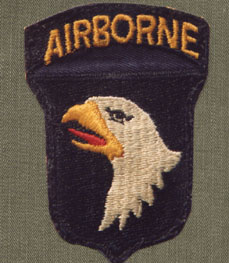 All Type 10's are characterized by a scribble eye-the details of which seem to be rendered with single strands of thread. Since the company which produced these in WW2, continued in production until probably 1968 (when merrowed edge Type 14s were introduced), these types create a lot of confusion. In most cases, unless you have provenance on a particular patch of this type, it is impossible to determine if it was issued during WW2 or much later. The example shown above, has the area between the tab and shield filled-in with black twill. It has provenance from Captain Bernard McKearney of E/502. I've only seen one other like this, and that is on the WW2 officers suntan jacket of Lt. Charles Matson of H/502. The few other WW2 verified examples I've seen of Type 10, have also been in the hands of 502 vets-that might mean something. I also suspect this Type was introduced late in WW2, accounting for the scarcity of examples with WW2 provenance.
All Type 10's are characterized by a scribble eye-the details of which seem to be rendered with single strands of thread. Since the company which produced these in WW2, continued in production until probably 1968 (when merrowed edge Type 14s were introduced), these types create a lot of confusion. In most cases, unless you have provenance on a particular patch of this type, it is impossible to determine if it was issued during WW2 or much later. The example shown above, has the area between the tab and shield filled-in with black twill. It has provenance from Captain Bernard McKearney of E/502. I've only seen one other like this, and that is on the WW2 officers suntan jacket of Lt. Charles Matson of H/502. The few other WW2 verified examples I've seen of Type 10, have also been in the hands of 502 vets-that might mean something. I also suspect this Type was introduced late in WW2, accounting for the scarcity of examples with WW2 provenance.
The vast majority of Type 10's have an attached Airborne tab, with the usual space cut out between tab and shield. In all, Type 10's are far from rare, because so many were made after WW2. But examples with WW2 vet provenance are relatively scarce.
POSTWAR SCRIBBLE EYES
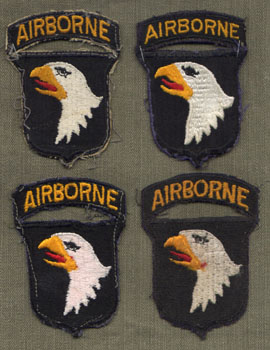 These have the same appearance as most WW2 Type 10s.
These have the same appearance as most WW2 Type 10s.
The above scribble-eye patches were all worn during the interim war period at Ft Campbell or up to the beginning of the NAM period. The example at top left appears to be mismatched with a Type 1 tab of WW2 vintage. There is a photo in 'Vietnam Odyssey', the history of the 1st Brigade, showing General Willard Pearson wearing this identical type of patch. I found this, as well as the patch at bottom right, in the patch bin of Brick's Army Store, across from the main gate at Ft Campbell, KY in 1975. The example at lower right is soaked with what smells like CS tear gas. It has all the characteristics of a WW2 patch-who knows when it was actually manufactured?
The patch at upper right came from Bill Steele, a WW2 G/502 vet, who wore this in the late 1950s at Ft Campbell. These are all cut edge patches and Steele's has a blue tinge to the edges, an apparent result of the black dye bleeding onto the tan edging from machine washing. The patch at bottom left was given to me by Gary Porter of 3/187,(Vietnam 67-68). Gary was issued the patch at Ft Campbell in 1967 just before going to Vietnam as part of Operation Eagle Thrust, which deployed the rest of the 101st to join the First Brigade. Like WW2 patches, Gary's example is still raw-edged. Some time within the next year, patches with merrowed-edges began to be issued, and the raw-edged WW2 style patches faded out of the picture. You will note that most of these patches also have traces of red thread at the inner hinge of the beak, a spillover from the tongue. Some scribble eyed patches were issued with Airborne tabs done in white lettering-again, no significance other than a probable shortage of orange thread at the patch factory.
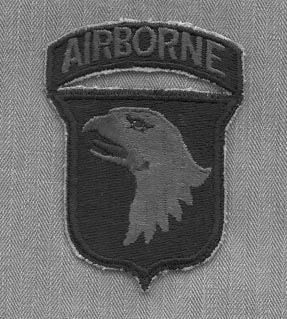 Here's something else for you patch collectors to chew on. I bought this scribble-eyed patch from a dealer who specializes in Vietnam War insignia and artifacts. He said he had gotten it from a NAM vet who had dyed it himself, to subdue it. You will note that this insignia has all the characteristics of a WW2 era patch. It did not reproduce well here but has a blackish-purplish dye covering it. I speculate that it was worn by a First Brigade LRRP. But wouldn't it be interesting to know when the patch itself was manufactured? It is true that it was against divisional policy to wear subdued 101st eagle patches during the Vietnam War, even in combat, and very few subdued examples were made at that time. This is supported not only by photographic evidence, but also by the few existing Theatre-Made subdued eagle patches dating from the NAM era. Captured NVA documents had revealed that the enemy feared the 101st, and advised their troops to try to avoid contact with Americans who wore the 'chicken patch'. A Japanese company which made professional-quality subdued patches of all the U.S. combat units in Vietnam did produce a 101st version, but it was not generally worn by the troops. 'Real' in-country-made black and green subdued eagle patches made in the RVN during the war are almost non-existent. I say 'Real', because a veritable cottage industry has blossomed in the U.S. since that war, with in-country repros being turned out on the sewing machines of unethical dealers' wives! They are turning out subdued fakes for ALL the combat units which fought in NAM. How are they supposed to know that the 101st didn't wear subdued patches in that war? However, many authentic full-color Gook-made in-country patches do exist, and will be addressed later.
Here's something else for you patch collectors to chew on. I bought this scribble-eyed patch from a dealer who specializes in Vietnam War insignia and artifacts. He said he had gotten it from a NAM vet who had dyed it himself, to subdue it. You will note that this insignia has all the characteristics of a WW2 era patch. It did not reproduce well here but has a blackish-purplish dye covering it. I speculate that it was worn by a First Brigade LRRP. But wouldn't it be interesting to know when the patch itself was manufactured? It is true that it was against divisional policy to wear subdued 101st eagle patches during the Vietnam War, even in combat, and very few subdued examples were made at that time. This is supported not only by photographic evidence, but also by the few existing Theatre-Made subdued eagle patches dating from the NAM era. Captured NVA documents had revealed that the enemy feared the 101st, and advised their troops to try to avoid contact with Americans who wore the 'chicken patch'. A Japanese company which made professional-quality subdued patches of all the U.S. combat units in Vietnam did produce a 101st version, but it was not generally worn by the troops. 'Real' in-country-made black and green subdued eagle patches made in the RVN during the war are almost non-existent. I say 'Real', because a veritable cottage industry has blossomed in the U.S. since that war, with in-country repros being turned out on the sewing machines of unethical dealers' wives! They are turning out subdued fakes for ALL the combat units which fought in NAM. How are they supposed to know that the 101st didn't wear subdued patches in that war? However, many authentic full-color Gook-made in-country patches do exist, and will be addressed later.
WW2 TYPE 14
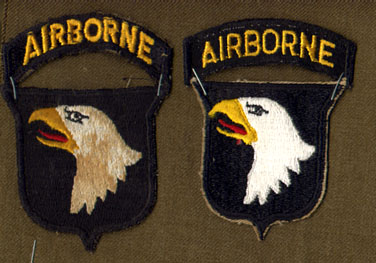 This type is worth illustrating and discussing, because it is often confused with the Type 10 scribble eye patch. Type 14's have a more solid line at the BOTTOM of the eagle's EYE. This type eye continued into the postwar Ft. Campbell era as a cut edge patch, with a distinct concentric raised area around the inner border of the shield and tab. In 1968, it became the most commonly produced merrowed edge type, and the same company has produced subdued variants, still recognizable by the eye design, to this day.
This type is worth illustrating and discussing, because it is often confused with the Type 10 scribble eye patch. Type 14's have a more solid line at the BOTTOM of the eagle's EYE. This type eye continued into the postwar Ft. Campbell era as a cut edge patch, with a distinct concentric raised area around the inner border of the shield and tab. In 1968, it became the most commonly produced merrowed edge type, and the same company has produced subdued variants, still recognizable by the eye design, to this day.
Back to WW2, I have only acquired about 5 of these from WW2 vets, causing me to do two things:
1: I've assigned it a high number for relative WW2 era rarity
2: I've theorized that production on these began late in WW2, but as noted above, this company resumed production in the postwar years and has continued to the present. Of the examples illustrated above, the left version has a very wide shield, like an oversized Type 9, and a very arced Airborne tab-this example came from 502nd medic Ed Zelonis. The normal sized example at right is from Robert Urge, who changed his name to Bob Burgess after WW2 (B/501). I've also seen a normal sized version, attributed to Col. X.B. Cox of the 81st Airborne AA/AT Bn., although I didn't get it directly from him. Also Frank Gregg of E/501 provided an example which I believe to be of WW2 origins although Col. Gregg remained in service until the late 1960s.
New Type 17
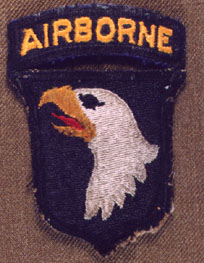 I had purchased a patch as shown above from a dealer at the MAX show in 2003. Having never received one from a vet, I hesitated to classify it as a WW2 Type. However in April, 2007, I received one in a grouping that belonged to Captain George Lage the 2nd Bn surgeon of the 502 PIR. Because this is only the second one I've ever seen, I now wish to upgrade it, from Origins Unknown, to Type 17, US made. This replaces the golden-eyed patch, which was formerly Type 17 but has been re-classified as Theatre Made.
I had purchased a patch as shown above from a dealer at the MAX show in 2003. Having never received one from a vet, I hesitated to classify it as a WW2 Type. However in April, 2007, I received one in a grouping that belonged to Captain George Lage the 2nd Bn surgeon of the 502 PIR. Because this is only the second one I've ever seen, I now wish to upgrade it, from Origins Unknown, to Type 17, US made. This replaces the golden-eyed patch, which was formerly Type 17 but has been re-classified as Theatre Made.
As to this new Type 17, is bears a certain similarity to Type 7's, with the upturned feature at the front of the eye. However, this patch was made without an attached Airborne Tab, the beak is higher where it meets the eagle's face, and I now believe that this variant deserves a Type number of it's own.
BRITISH MADE PATCHES
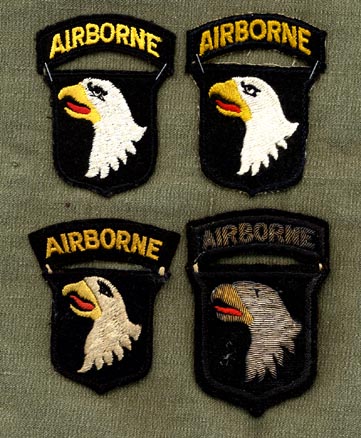 When the 101st Airborne Division arrived in the U.K. in the fall of 1943, the personnel experienced shortages in a number of commodities, the most important of which was food. But certain other non-essentials, like divisional shoulder patches were also in short supply, so batches were procured from local insignia manufacturers. The biggest firms in London, turned out many patches, probably numbering in the thousands.
Types B-1 and B-2 are fairly common and look very much alike at first glance. However, the white portion of Type B-1 is embroidered with ripples of thin white cotton thread on a black
wool base, while Type B-2 has single long lines of thicker white thread running diagonally across the width of the head and neck.
Type B-1 has a black finish on the reverse, while Type B-2 has a
white cloth backing. All of the first four Brit made Types have seperate Airborne tabs.
When the 101st Airborne Division arrived in the U.K. in the fall of 1943, the personnel experienced shortages in a number of commodities, the most important of which was food. But certain other non-essentials, like divisional shoulder patches were also in short supply, so batches were procured from local insignia manufacturers. The biggest firms in London, turned out many patches, probably numbering in the thousands.
Types B-1 and B-2 are fairly common and look very much alike at first glance. However, the white portion of Type B-1 is embroidered with ripples of thin white cotton thread on a black
wool base, while Type B-2 has single long lines of thicker white thread running diagonally across the width of the head and neck.
Type B-1 has a black finish on the reverse, while Type B-2 has a
white cloth backing. All of the first four Brit made Types have seperate Airborne tabs.
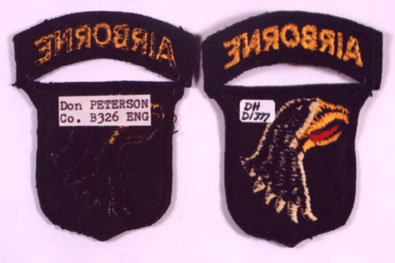 The above photo shows the reverse side of 2 named Type B-1 patches. As I've stated, the reverse of these is black, or mostly black. The example at right comes from Lt Hettrick of D/377th PFAB. Although the obverse looks almost identical to the specimen at left, there are some notable differences on the reverse-still both are Type B-1's.
The above photo shows the reverse side of 2 named Type B-1 patches. As I've stated, the reverse of these is black, or mostly black. The example at right comes from Lt Hettrick of D/377th PFAB. Although the obverse looks almost identical to the specimen at left, there are some notable differences on the reverse-still both are Type B-1's.
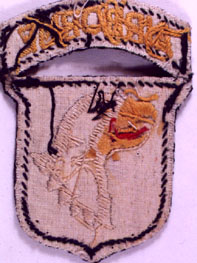 This is a good shot of the reverse of a Type B-2. All of these types have the characteristic white cheesecloth backing. On the obverse, they look very similar to Type B-1's.
This is a good shot of the reverse of a Type B-2. All of these types have the characteristic white cheesecloth backing. On the obverse, they look very similar to Type B-1's.
Eagle Patches Everywhere
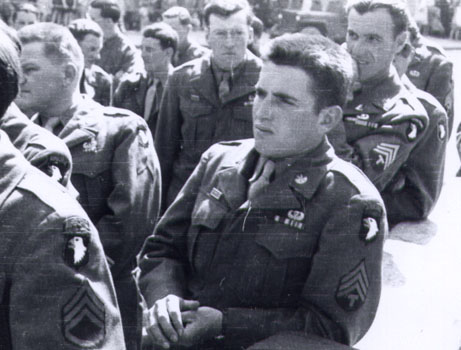 At this postwar assembly in Austria, soon after VE-Day in 1945, a lot of eagle patches can be seen. The two closest to the camera, worn by the staff sergeant and the Technician 4th grade, are, not surprisingly, both Type 1's. The T/4 at upper right wears a Type B-1 British made SSI, recognizable even from a slight distance.
At this postwar assembly in Austria, soon after VE-Day in 1945, a lot of eagle patches can be seen. The two closest to the camera, worn by the staff sergeant and the Technician 4th grade, are, not surprisingly, both Type 1's. The T/4 at upper right wears a Type B-1 British made SSI, recognizable even from a slight distance.
Type B-3-'Ugly Head' Bird
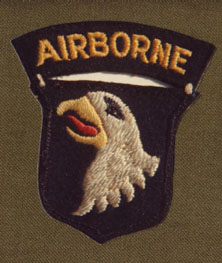 Type B-3 features an ugly bird with a
round domed head and very slanted eye. The reverse is partially covered with fine crisscrossed white 'netting' and partially covered with black paper. The Airborne tab usually paired with this patch slants outward toward the top at both ends. The
beak, as well as the Airborne letters are distinctly yellow in color. Once again, the design is cotton embroidery on a base of black wool. These patches were sold at a shop in Picadilly, and
for slightly more in cost, could be silvered-over by a process which was done in front of the buyer on a special machine. The
procedure took only a few minutes, and resulted in a sub-variant of Type B-3. The tailors would also sew the patch onto your uniform while you waited.
Type B-3 features an ugly bird with a
round domed head and very slanted eye. The reverse is partially covered with fine crisscrossed white 'netting' and partially covered with black paper. The Airborne tab usually paired with this patch slants outward toward the top at both ends. The
beak, as well as the Airborne letters are distinctly yellow in color. Once again, the design is cotton embroidery on a base of black wool. These patches were sold at a shop in Picadilly, and
for slightly more in cost, could be silvered-over by a process which was done in front of the buyer on a special machine. The
procedure took only a few minutes, and resulted in a sub-variant of Type B-3. The tailors would also sew the patch onto your uniform while you waited.
Type B-4 Bullion
 Type B-4 is the most common of the true bullion, or metallic wire patches made in England. The wire used for the beak and AIRBORNE letters is a gold color, while the head and neck were originally in a bright silver color. Time has caused the originals to fade to gray with tarnishing. Of the design features on Type B-4, only the red tongue is made of cotton thread. These were purchased at an Army Navy shop in Paddington Station, London at a wartime price of 1 pound each. About 5 additional Brit made eagle patch variants are illustrated and described in my 'Trigger Time' website book, as well as my Trigger Time Eagle Patch reference guide-(see Books page).
Type B-4 is the most common of the true bullion, or metallic wire patches made in England. The wire used for the beak and AIRBORNE letters is a gold color, while the head and neck were originally in a bright silver color. Time has caused the originals to fade to gray with tarnishing. Of the design features on Type B-4, only the red tongue is made of cotton thread. These were purchased at an Army Navy shop in Paddington Station, London at a wartime price of 1 pound each. About 5 additional Brit made eagle patch variants are illustrated and described in my 'Trigger Time' website book, as well as my Trigger Time Eagle Patch reference guide-(see Books page).
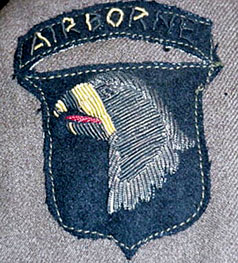 The bullion example illustrated above, surfaced recently at a Michigan estate sale. Collector Steve Berge purchased an Ike jacket bearing this apparently Brit made example, which is of a style I had not seen before. The original owner was a replacement in F/502. Note how some of the gold strands on the lettering and sections of the eagle's beak have darkened considerably with tarnish, while other spots remain much brighter.
The bullion example illustrated above, surfaced recently at a Michigan estate sale. Collector Steve Berge purchased an Ike jacket bearing this apparently Brit made example, which is of a style I had not seen before. The original owner was a replacement in F/502. Note how some of the gold strands on the lettering and sections of the eagle's beak have darkened considerably with tarnish, while other spots remain much brighter.
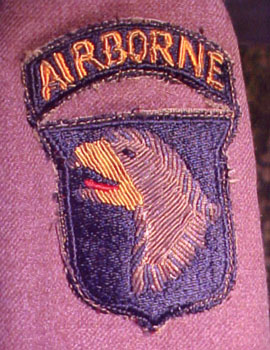 Here's another modified example, which surfaced recently, and appears courtesy of the Bob Carter collection. This appears to have started as a U.S. made Type 3, with amoeba eye and attached Airborne tab. A layer of metallic wire 'bullion' thread was sewn over the existing head, neck and beak, probably done while in the E.T.O.
Here's another modified example, which surfaced recently, and appears courtesy of the Bob Carter collection. This appears to have started as a U.S. made Type 3, with amoeba eye and attached Airborne tab. A layer of metallic wire 'bullion' thread was sewn over the existing head, neck and beak, probably done while in the E.T.O.
Don Burgett's Patch
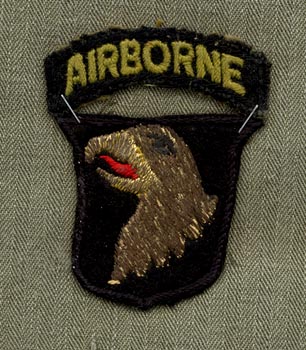 One night in 1994, Don Burgett visited my home and viewed some uniforms in my collection. Upon seeing a bullion British-made 101st patch, he recalled-"Oh yeah-I had a metallic wire patch on my dress uniform, but I haven't seen it in 25 years or more."
Don wasn't feeling well that night. He drove home (almost an hour's drive), and went to bed. The next morning when Don awoke, he walked into the bedroom which serves as his office, and
there, lying in plain view on the top of his desk was the Type B-3 subvariant patch (minus tab), shown above. When Don mailed the patch to me, part of the accompanying letter read:
One night in 1994, Don Burgett visited my home and viewed some uniforms in my collection. Upon seeing a bullion British-made 101st patch, he recalled-"Oh yeah-I had a metallic wire patch on my dress uniform, but I haven't seen it in 25 years or more."
Don wasn't feeling well that night. He drove home (almost an hour's drive), and went to bed. The next morning when Don awoke, he walked into the bedroom which serves as his office, and
there, lying in plain view on the top of his desk was the Type B-3 subvariant patch (minus tab), shown above. When Don mailed the patch to me, part of the accompanying letter read:
(April 16, 1994) "...I did give my Eisenhower jacket away to a young, fatherless man that needed a jacket, but I took the shoulder patch off and kept it in my travels to California,(3 years) and back. It took a real beating over the years and one day it seems that I had threw it away in the rubbish. Then I forgot about it until our visit. The next morning I went into my office and there it was, laying on the center of my desk. I asked (my wife) and the rest of my family how it got there, where was it found, and why now, it was put there.
No one found it, no one put it there, and yet, there it was. I did not unknowingly find it and put it out that night for me to find the next morning. I don't know where it came from or how it got there, and why that particular night, after all these years? I was not on medication of any kind and have not had a drink of alcohol in over eight years. It's spooky Mark, but I can live with that.
Maybe that beat up old patch is blessed somehow, and maybe there is someone watching over me? Perhaps one of my family did find it and put it out, but why that night? And where would they find it? You have seen my office; even I can't find what I want in there. Well, for whatever reason, and for what it's worth,
it's yours. Take care of it. This is the patch I had on my jacket when I had my picture taken at Mourmelon le Petit, France. That photo is on the back jacket of my book "Currahee"
(original Houghton-Mifflin editions). I purchased the patch at the little tailor shop in Picadilly...they metal stitched it while I waited, and sewed it on for me. This was done after we returned from Normandy and received our Furloughs.
I really do believe one of my family did put that patch out that night and just doesn't want to say so. But why that night? They were all asleep when I got home and I didn't say anything about it. In fact, my family knew nothing of the patch, for I had "thrown" it away years ago."
Webmaster's comments: This Type B-3 patch purchased by Don, had
already been made as a standard B-3, but was metal wired-over the original cotton thread for an additional charge. I have placed a well worn Brit-made Airborne tab with Don's patch to complete the picture. His tab did get lost and has stayed lost
over the years-so far. By the way, I've also experienced the reverse scenario, wherein WW2 items have spontaneously vaporized
into thin air, disappearing just as surely as this patch materialized. Yes, it is spooky!-M.B.
Note from the webmaster: A much more detailed, illustrated discussion of over 70 variants and sub-variants of the 101st Airborne SSI is available in my website book, 'Trigger Time Eagle Patch Guide'.
See Books page for ordering information. On the next page, you'll find a discussion of Vietnam War era and other post WW2 era eagle patches. M.B.
















